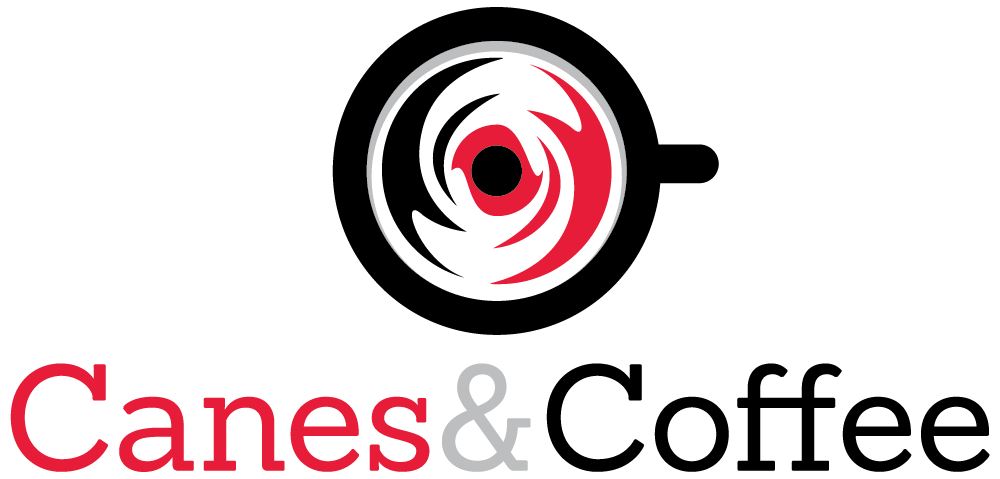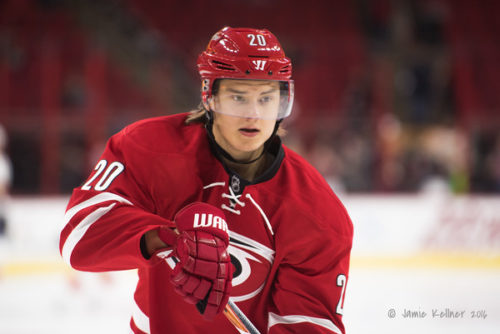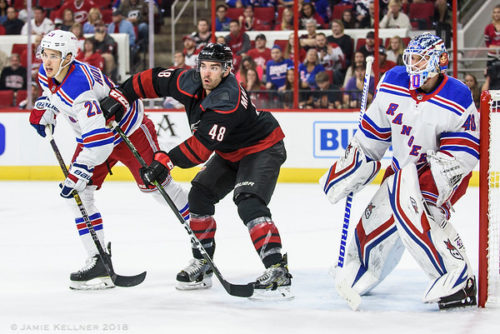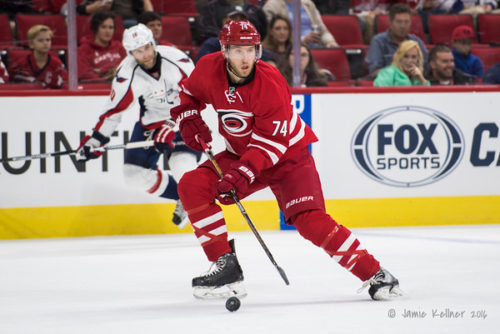For those who were away from Canes hockey on Tuesday, heavy news dropped that after 39 years Chuck Kaiton would no longer be the radio voice of the Carolina Hurricanes.
My initial Twitter-size thoughts followed by a full article on Chuck Kaiton’s departure are HERE.
As part of a few Twitter exchanges after the news broke, I tweeted the following:
Very good point, and I do not disagree. But I guess personally, my Mount Rushmore for @NHLCanes hockey is Brind'Amour & Francis (1st generation), Forslund & Kaiton (core/fabric of community spanning entirety of NC history) and Ward & Eric Staal (2nd generation).
— Canes and Coffee (@CanesandCoffee) July 24, 2018
I have since had a couple brief exchanges asking whether I would really put Chuck Kaiton as an announcer in such a small group. The question sort of suggests that my inclusion could just be a short-term slight overreaction based on the news at hand, but when I think through it in detail, I really think that Chuck Kaiton belongs in the group.
Today’s Daily Cup of Joe defends that position and does a deeper dive into identifying a very select group of icons of two decades of Carolina Hurricanes hockey.
Defending Chuck Kaiton and similarly John Forslund
When making an extremely short list of icons, some might argue that only players or possibly coaches belong in such a small group. I actually believe the opposite. When television or radio announcers span a long run of history as they can better than players whose careers are limited by physical ability, good ones have the potential to become part of the deepest layer or fabric of the team’s history and community. With both Chuck Kaiton and John Forslund having been part of the organization since its arrival in North Carolina (and significantly before that especially for Chuck Kaiton), they have been part of all it – the highest highs, the lowest lows…the optimism, the success and the glory…but also the crushing defeats, despair and times when fans needed something, anything, to hold on to. As such announcers like Kaiton and Forslund can become deeply ingrained in the totality of the fan experience and fan community.
In the case of Chuck Kaiton (and John Forslund), their place in Hurricanes history has been exactly that but even more. Both played integral roles as ambassadors for the team and NHL hockey in general when the team fell out of the sky into a non-traditional hockey market with no forewarning. Two things were significantly different about Hurricanes hockey in those pioneer days. First, the team televised only a little over half of the team’s games. That meant for those looking to take in many games, the only option was Chuck Kaiton on the radio. So whereas, there are so many options to track a Hurricanes game live with 82-game television coverage, DVRs and ever-present mobile devices, for the first wave of Canes fans back in the late 1990s and early 2000s, Chuck Kaiton was a core part of Canes fandom. And for me personally (and verified regularly by others who picked the team up in this time frame), Kaiton’s unique style and delivery is something that became permanently intertwined with what Hurricanes hockey was. But in addition to being such an integral part of the Hurricanes experience from a that era, I think even more significant is Chuck Kaiton’s role (and again John Forslund too) as an ambassador for the team and more broadly the game. At this point in time, a huge swath of the team’s fan base were people like me who were giving it a try. Kaiton and Forslund were very much faces and voices of the team for the ‘considering’ fan base, and both were absolutely phenomenal in this role. Both were so incredibly sincere in their interaction with fans and ready to meet fans wherever they were ranging from brand new fans who asked what the blue line was for to transplants who grew up with the game and were 30 years deep into passionate NHL fandom. Because Kaiton and Forslund were so much front and center in the team’s relations with fans, they set the precedent for how the fan base connected with the hockey community. In the process, I think both men along with early players who similarly embraced an ambassador role were largely responsible for what to this day I consider to be a unique relationship between the team and the local hockey community. So in this role as ‘builders’ I stick to my initial statement that though they are not players both Chuck Kaiton and John Forslund should make the cut into an incredibly select group on a Carolina Hurricanes Mount Rushmore.
Considering Canes history by eras
When trying to make a short list of faces for a Carolina Hurricanes Mount Rushmore, my starting point is breaking down the team’s history into eras. With the odd gaps of on-ice struggles between the few high peaks, the time segments break out pretty clearly for me.
The foundational era (1997-98 – 2000-01)
For me the first era in Canes hockey spans the team’s arrival in North Carolina for the 1997-98 season through the 2000-01 season that officially established NHL hockey in North Carolina. The Greensboro years were not without their struggles with the transition years before arriving in Raleigh and challenges with attendance and building any semblance of a fan base early on. The way fan embraced the team with a rousing standing ovation at the end of game 6 of the 2000-01 playoff series against the New Jersey Devils still sends chills down my spine. At a basic level, the event was a sudden and massive repayment of all of the goodwill put forward by those early ambassadors who made the team likable.
Mount Rushmore entries: Chuck Kaiton, John Forslund.
Honorable mentions: Glen Wesley. If I had to pick a single player who most embraced and led in the same ambassador role, I think I would give Glen Wesley the slight edge over Ron Francis winning tiebreaker by virtue of being part of the effort from day 1 in North Carolina.
The official arrival of hockey in Raleigh, North Carolina (2001-02)
The 2000-01 season built up to it, but for me the official arrival of NHL hockey in North Carolina came during the run to the Stanley Cup Finals in the 2002 NHL Playoffs.
The 2002 Stanley Cup Playoff run proved that there could be a market and a passion for an NHL hockey team in Raleigh, North Carolina if the team was successful. This is when the initial core of the team’s fan base was established and also when it finally became clear that at least under some circumstances an NHL team was viable. Ron Francis played a huge role in establishing the team’s credibility
Mount Rushmore entries: Ron Francis.
Honorable mentions: Arturs Irbe. More than any other player from the 2001-02 season, I think Arturs Irbe and his quirkiness with his old school bucket style helmet, knitting proficiency with his ancient pads and his undersized, underdog style of play epitomized the state of the Hurricanes fan base at this time. Like Irbe, the the fan base was non-traditional, quirky and maybe just downright odd by NHL standards. This is when tailgating became permanently intertwined with Hurricanes hockey and the then Entertainment and Sports Arena became one of the loudest venues in NHL hockey with a ‘when in doubt scream’ mentality of a young fan base forging its own way. Rod Brind’Amour could fit here too, but I view the 2001-02 team as Francis’ team just like the 2005-06 team was Brind’Amour’s. As such Brind’Amour fits better in the next winning era.
A valley (2002-03 through 2004-05)
Then came the first a couple extended down periods that saw the team stumble mightily in 2002-03 and 2003-04 leading into the 2004-05 season that was lost to the lockout. Just as quickly as the franchise had build something special in 2000-01 and 2001-02, it spent the next three years seemingly dismantling the entirety of what was built during the two-year playoff run. One of very few positives during this time frame was the commitment of Rod Brind’Amour to the team when he could just as easily have asked to be dealt to a contender a la Jeff O’Neill.
A triumphant return and a championship (2005-06)
Even faster than everything had been lost, all of it was suddenly regained in one magical season. Peter Laviolette effected an unmistakable change in attitude, and the team that benefited from the salary cap and fortuitously had a team built for the rule changes hit the ground running coming out of the lockout. The first line of Cory Stillman-Eric Staal-Erik Cole was as good as any in hockey until Cole was injured. The duo of Rod Brind’Amour and Justin Williams made for an elite checking line that also scored. And the Matt Cullen along cap casualty Ray Whitney made the team as deep offensively as any in Hurricanes history. Led by do-everything captain Rod Brind’Amour, the team rolled through the regular season and then after an initial hiccup did the same in exhilarating fashion in the playoffs. The result was an absolutely improbable hoisting of the Stanley Cup in Raleigh, North Carolina on June 21, 2006.
Mount Rushmore entries: Rod Brind’Amour.
Honorable mentions: One could obviously put Eric Staal and/or Cam Ward here because of their roles in the 2005-06 run, but keeping with my previous logic, I think the championship team was Brind’Amour’s team and that Ward and Staal fit at least equally well as leaders of the next peak. I also think that Peter Laviolette is a candidate for an expanded Mount Rushmore though his candidacy is decreased by the fact that his success with the team was just the single magical season. Erik Cole is another who would deserve consideration. He is one of only three players (Rod Brind’Amour and Niclas Wallin are the other two.) who span all three deep playoff runs.
The next valley (2006-07 to 2007-08)
Repeating history, after a magical season the Hurricanes fell hard and missed the playoffs in the next two seasons before rebounding again. The fall represented another transition with the departure of Laviolette and a number of other players from the Stanley Cup team.
The next generation leads the way (2008-09)
After a couple tough years of unmet hopes, the young guns from the 2005-06 season rose up. Conn-Smythe winner Cam Ward took a couple years to grow into the starting role but arrived in full force for the 2008-09 season that saw him win a career high 39 games and post a career high .916 save percentage (matched in 2009-10). He was absolutely stellar in two underdog series wins that featured tight games, a ton of pressure and zero margin for error. In defeating Martin Brodeur for the second time in two tries, Ward established himself as a clutch playoff performer. On the offensive side of the puck, Eric Staal led the way both in the regular season and in the playoffs. After an ahead of schedule outburst in the magical 2005-06 season, the 2008-09 was right in the middle of Staal’s best run of hockey in a Hurricanes uniform. In addition, Staal was arguably the team’s best skater (Pitkanen also had a case) for the two stunning game 7 playoff series wins. Following the patter than declared the 2001-02 team to be Francis’ and the 2005-06 team to be Brind’Amour’s, I very much think the the 2008-09 team was jointly Staal’s and Ward’s. Though the season proved surprisingly to be a peak from which the team would constantly decline, that season combined with the lead up to hosting the 2010 NHL All-Star game represented the third peak in Hurricanes history.
Mount Rushmore entries: Eric Staal, Cam Ward.
Honorable mentions: Ray Whitney. He is another who spanned two deep playoff runs. Whitney’s 77 points in 2008-09 tied his career high and extended his run in a Hurricanes uniform to five years and more than 300 points.
The current extended valley (2009-10 to present)
Though it represented yet another post-playoff flop, the 2009-10 season was special if only for the absolutely wonderful weekend hosting the 2010 NHL All-Star Game. Eric Staal and Cam Ward had become legitimate NHL stars, and freshman phenom Jeff Skinner was taking the NHL by storm on his way to winning the Calder Trophy. At the time, one would never have guessed the extended struggles that would follow.
Mount Rushmore entries: None. The lack of team success makes it tough to include any player who is primarily from this era on a short list.
Honorable mentions: Jeff Skinner. Aside from the carry over of Eric Staal, Jeff Skinner most represents the face of the franchise for any period of time beyond the past year or two.
Looking forward to the next era
When I look forward to the next era of players who could quickly vault into consideration for a Mount Rushmore spot, I see a couple different categories.
Building on past success: If Justin Williams is named captain as is possible and leads the team back to the playoffs or farther, that accomplishment would pair nicely with his role in the 2006 Stanley Cup Championship and boost his status in franchise history.
Looking for measurable team success: Jeff Skinner especially but also possibly Justin Faulk and Jordan Staal have extended runs with the team but not a single playoff game among them. Especially for Skinner, playing a role in a team accomplishment would add nice balance to the personal scoring totals that he has amassed over time.
Truly the next generation: Past the long-timers, it is quite possible that the next contenders for Mount Rushmore spots come from a completely new generation that does not have so many years of non-playoff season baggage as part of their legacy. Sebastian Aho is probably front and center, but players like Jaccob Slavin or even Andrei Svechnikov, Martin Necas or other young guns are not out of the question five years down the road.
What say you Canes fans?
1) Counting my six for Mount Rushmore and six honorable mentions, I have 12 players. If you could add only one more play to make a baker’s dozen at 13, who would it be?
2) If selecting six like I did (yes I realize the actual Mount Rushmore has only four), do you agree with my six? If not, which players would comprise your list?
3) Who else, if anyone, would you add to an honorable mention list?
4) Of players currently on the Hurricanes roster, which player(s) do you think have the best chance to be in a discussion like this in five years?
Go Canes!




I have a nomination,but first a little background…
The year of the “lockout” -year before winning the silver thing-
Our group who tailgated b4 EVERY GAME (several years), which had its own website “The Eastgate Tailgate”, decided we would tailgate on the day the season was supposed to start!
Somehow one of the players found out about our PLAN, SOOOOO we were pleasantly surprised by “my nomination” Kevin Adams! He came out to our tailgate and talked with us and told us he wasn’t happy about the situation either…he wanted to play hockey just as we wanted to see it!
Kevin (like most players) just wanted to play!
He was, and is a class act!
That is a great story! Thank you for sharing it.
Kevyn Adams was an unsung hero on the 4th line and penalty kill for both the 2002 and 2006 Stanley Cup runs, and as you said, he like the vast majority of Hurricanes players is also a class act as a person.
If he hadn’t been traded unceremoniously from the team I’d put the Juice (Jussi Jokanen) into the conversation.
His dramatic 2009 playoff run heroics rate up there as some of the team’s finest. His name changed the singing of the national anthem at the RBC Center.
But he was traded away during one of the team’s worst seasons and his stint with the team was probably to brief to earn him a Mount Rushmore badge, but I’d say he’s solidly in the honorable mentions category.
Your top six are:
1) Chuck Kaiton
2) John Forslund
3) Ron Francis
4) Rod Brindamour
5) Eirc Staal
6) Cam Ward
I would let John Forslund slide to “Honorable Mention” replacing Arturs Irbe.
In Forslund’s place on the Mount, I would place Jimmy Rutherford.
Your Honorable Mention:
1) Glen Wesley
2) Irbe/Forslund
3) Peter Laviolette
4) Eric Cole
5) Ray Whitney/Niklas Wallin
6) Jeff Skinner
I would replace Ray Whitney with Nikki Wallin. Wallin was drafted by the Canes and played all but the end of his career with the Canes. He was “the Secret Weapon”. He never scored much, but he scored 4 goals in the playoffs. All 4 were game winners. 3 were in overtime.
I would have to add, as Honorable Mention, Ron Biscotti – for his role as “Ron the Ref” and not “Ron, Head of PNC Security”.
He was hired in 1997 to introduce the rules of the game to the NC audience and then became the in-game host and was with the Canes for 17 years. He was a great ambassador for the Canes at public events and took the time to meet and greet people both while wearing ref stripes or not.